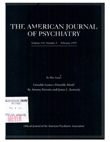Secondary mania following traumatic brain injury
Abstract
OBJECTIVE: In this study patients were examined during the first year after traumatic brain injury to determine the presence of secondary mania. METHOD: A consecutive series of 66 patients with closed-head injury were evaluated in the hospital and at 3-, 6-, and 12-month follow-ups. The patients were examined with a semistructured psychiatric interview and scales for measurement of impairment in activities of daily living, intellectual function, and social functioning. Patients fulfilling the DSM-III-R criteria for mania were compared to patients with major depression and to patients without affective disturbances in regard to their background characteristics, impairment variables, and lesion locations. RESULTS: Six patients (9%) met the criteria for mania at some point during follow-up. The presence of temporal basal polar lesions was significantly associated with secondary mania even when the effect of other lesion locations was taken into account. Secondary mania was not found to be associated with the severity of brain injury, degree of physical or cognitive impairment, level of social functioning, or previous family or personal history of psychiatric disorder. The duration of mania, however, appeared to be brief, lasting approximately 2 months. CONCLUSIONS: The 9% frequency of secondary mania in these patients with traumatic brain injury is significantly greater than that seen in other brain-injured populations (e.g., patients with stroke). The major correlate was the presence of a temporal basal polar lesion.
Access content
To read the fulltext, please use one of the options below to sign in or purchase access.- Personal login
- Institutional Login
- Sign in via OpenAthens
- Register for access
-
Please login/register if you wish to pair your device and check access availability.
Not a subscriber?
PsychiatryOnline subscription options offer access to the DSM-5 library, books, journals, CME, and patient resources. This all-in-one virtual library provides psychiatrists and mental health professionals with key resources for diagnosis, treatment, research, and professional development.
Need more help? PsychiatryOnline Customer Service may be reached by emailing [email protected] or by calling 800-368-5777 (in the U.S.) or 703-907-7322 (outside the U.S.).



